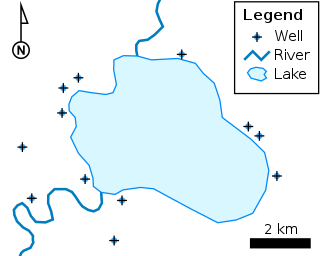
Extensible Markup Language (XML) is a markup language and file format for storing, transmitting, and reconstructing arbitrary data. It defines a set of rules for encoding documents in a format that is both human-readable and machine-readable. The World Wide Web Consortium's XML 1.0 Specification of 1998 and several other related specifications—all of them free open standards—define XML.
XSD, a recommendation of the World Wide Web Consortium (W3C), specifies how to formally describe the elements in an Extensible Markup Language (XML) document. It can be used by programmers to verify each piece of item content in a document, to assure it adheres to the description of the element it is placed in.

The Geography Markup Language (GML) is the XML grammar defined by the Open Geospatial Consortium (OGC) to express geographical features. GML serves as a modeling language for geographic systems as well as an open interchange format for geographic transactions on the Internet. Key to GML's utility is its ability to integrate all forms of geographic information, including not only conventional "vector" or discrete objects, but coverages and sensor data.
GPX, or GPS Exchange Format, is an XML schema designed as a common GPS data format for software applications. It can be used to describe waypoints, tracks, and routes. It is an open format and can be used without the need to pay license fees. Location data is stored in tags and can be interchanged between GPS devices and software. Common software applications for the data include viewing tracks projected onto various map sources, annotating maps, and geotagging photographs based on the time they were taken.
An XML schema is a description of a type of XML document, typically expressed in terms of constraints on the structure and content of documents of that type, above and beyond the basic syntactical constraints imposed by XML itself. These constraints are generally expressed using some combination of grammatical rules governing the order of elements, Boolean predicates that the content must satisfy, data types governing the content of elements and attributes, and more specialized rules such as uniqueness and referential integrity constraints.
Garmin Ltd. is an American, Swiss-domiciled multinational technology company founded in 1989 by Gary Burrell and Min Kao in Lenexa, Kansas, United States, with headquarters in Olathe, Kansas. Since 2010, the company is legally incorporated in Schaffhausen, Switzerland.

JSON is an open standard file format and data interchange format that uses human-readable text to store and transmit data objects consisting of attribute–value pairs and arrays. It is a common data format with diverse uses in electronic data interchange, including that of web applications with servers.
The PBCore metadata standard was created by the public broadcasting community in the United States of America for use by public broadcasters and related communities that manage audiovisual assets, including libraries, archives, independent producers, etc. PBCore is organized as a set of specified fields that can be used in database applications, and it can be used as a data model for media cataloging and asset management systems. As an XML schema, PBCore enables data exchange between media collections, systems and organizations.
The Global Justice XML Data Model is a data reference model for the exchange of information within the justice and public safety communities. The Global JXDM is a product of the Global Justice Information Sharing Initiative's (Global) Infrastructure and Standards Working Group (ISWG), and was developed by the Global ISWG's XML Structure Task Force (XSTF).
NIEMOpen, frequently referred to as NIEM, originated as an XML-based information exchange framework from the United States, but has transitioned to an OASISOpen Project. This initiative formalizes NIEM's designation as an official standard in national and international policy and procurement. NIEMOpen's Project Governing Board recently approved the first standard under this new project; the Conformance Targets Attribute Specification (CTAS) Version 3.0. A full collection of NIEMOpen standards are anticipated by end of year 2024.
This article describes the technical specifications of the OpenDocument office document standard, as developed by the OASIS industry consortium. A variety of organizations developed the standard publicly and make it publicly accessible, meaning it can be implemented by anyone without restriction. The OpenDocument format aims to provide an open alternative to proprietary document formats.

The Oxygen XML Editor is a multi-platform XML editor, XSLT/XQuery debugger and profiler with Unicode support. It is a Java application so it can run in Windows, Mac OS X, and Linux. It also has a version that can run as an Eclipse plugin.
Geospatial metadata is a type of metadata applicable to geographic data and information. Such objects may be stored in a geographic information system (GIS) or may simply be documents, data-sets, images or other objects, services, or related items that exist in some other native environment but whose features may be appropriate to describe in a (geographic) metadata catalog.
Data exchange is the process of taking data structured under a source schema and transforming it into a target schema, so that the target data is an accurate representation of the source data. Data exchange allows data to be shared between different computer programs.
The Open Packaging Conventions (OPC) is a container-file technology initially created by Microsoft to store a combination of XML and non-XML files that together form a single entity such as an Open XML Paper Specification (OpenXPS) document. OPC-based file formats combine the advantages of leaving the independent file entities embedded in the document intact and resulting in much smaller files compared to normal use of XML.
DDL is part of the MPEG-7 standard. It gives an important set of tools for the users to create their own Description Schemes (DSs) and Descriptors (Ds). DDL defines the syntax rules to define, combine, extend and modify Description Schemes and Descriptors.
XQuery is a query and functional programming language that queries and transforms collections of structured and unstructured data, usually in the form of XML, text and with vendor-specific extensions for other data formats. The language is developed by the XML Query working group of the W3C. The work is closely coordinated with the development of XSLT by the XSL Working Group; the two groups share responsibility for XPath, which is a subset of XQuery.

Akoma Ntoso (Architecture for Knowledge-Oriented Management of African Normative Texts using Open Standards and Ontologies) is an international technical standard for representing executive, legislative and judiciary documents in a structured manner using a domain specific, legal XML vocabulary.




